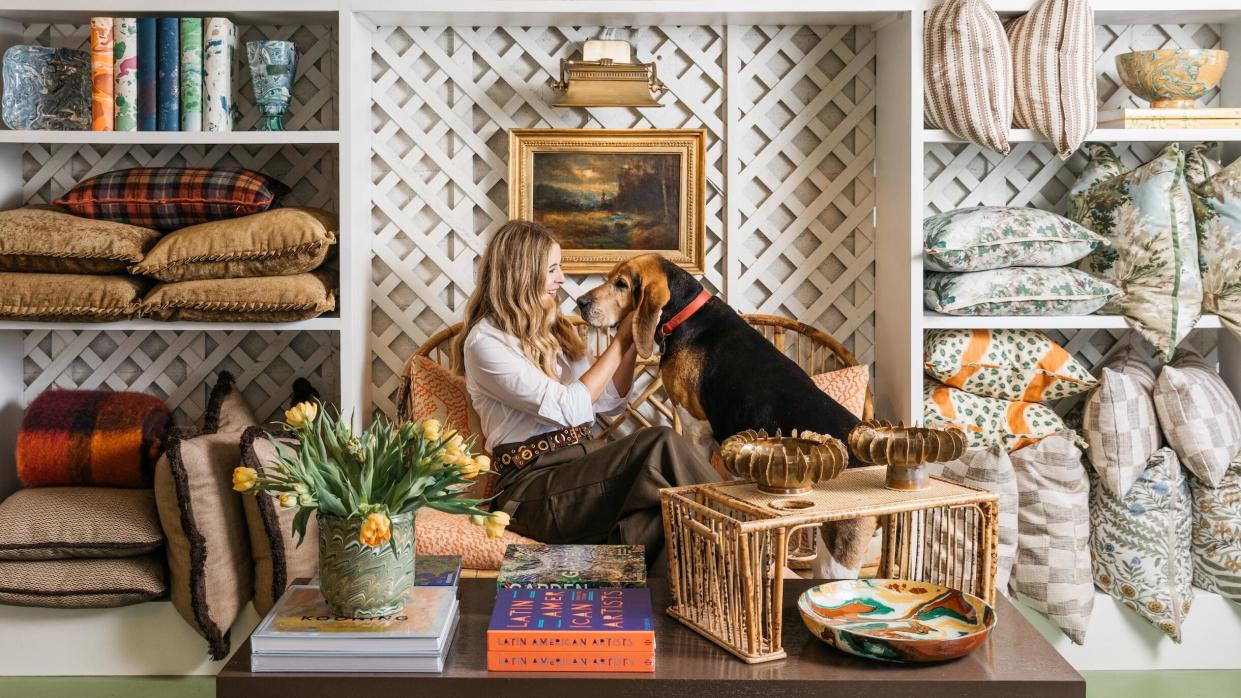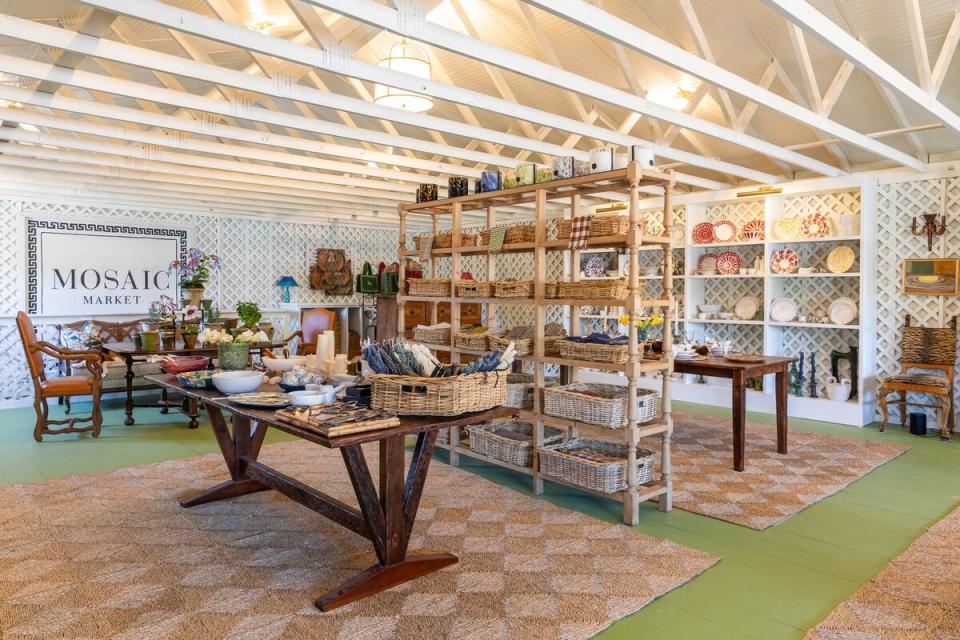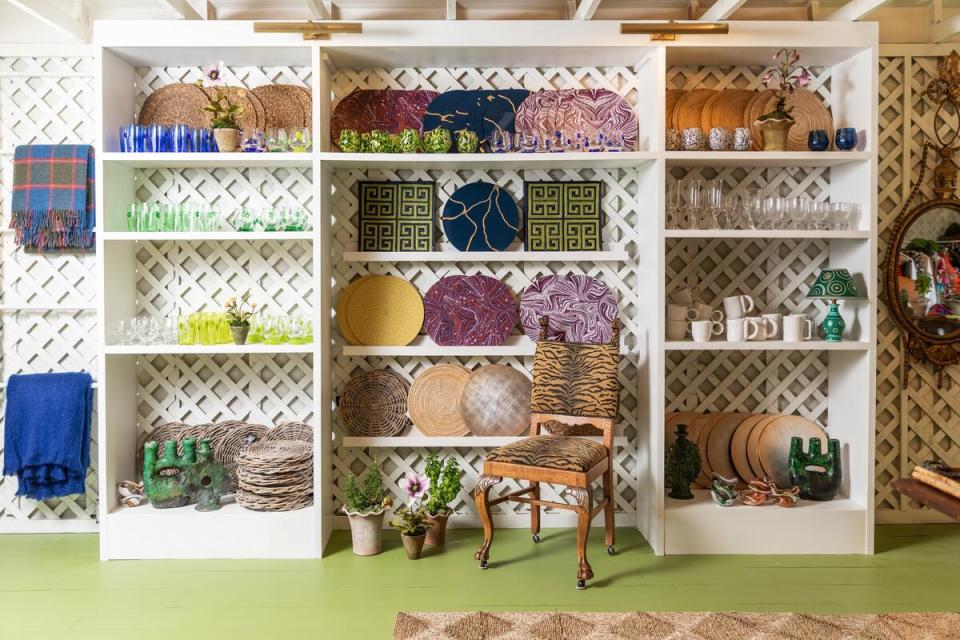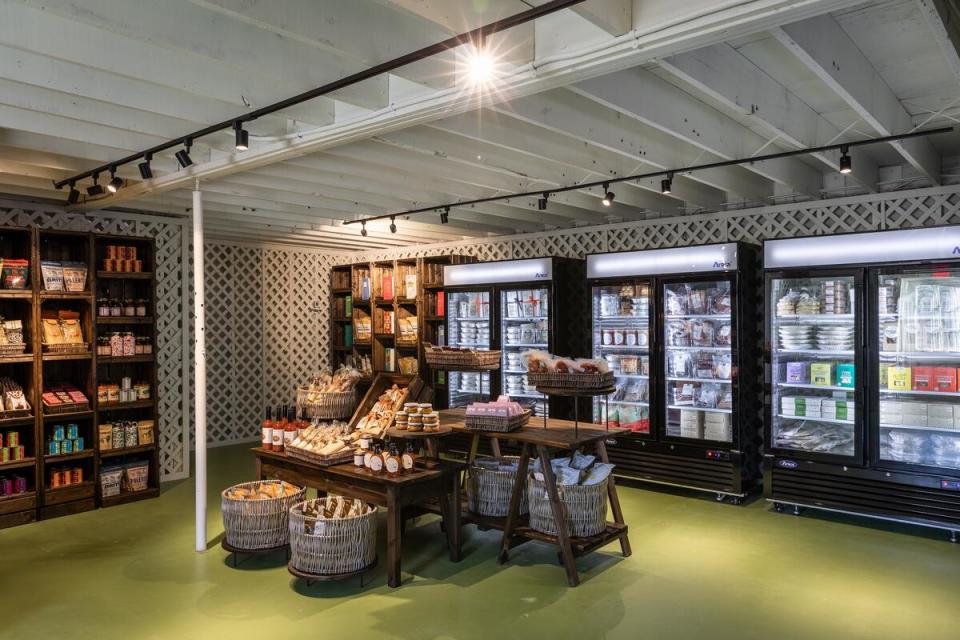This Chattanooga retailer takes wild risks with some of her vendors

Shop Talk | Mar 27, 2024
In Business of Home’s series Shop Talk, we chat with owners of home furnishings stores across the country to hear about their hard-won lessons and challenges, big and small. This week, we spoke with Yancey Kenna Martin, an interior designer and owner of Mosaic Home & Market in Chattanooga, Tennessee.
“I tried everything else along the way until I got here,” says Martin. “I was always so close.” She’s not kidding: Her career includes stints in New York and Los Angeles, across fashion PR, advertising, branded content and creative direction. The jobs and cities honed her concepts of creativity, while her sense of style was born closer to home. “I’d grown up in Atlanta, and my grandmothers were really intrepid travelers—women who put together beautiful homes that were unique. Nothing cookie-cutter or mass-produced about them,” she explains. “When I started decorating my own home, I realized there was so much I had yet to learn about this industry. I was just captivated.”
Following a “walkabout” in Morocco and Turkey (which inspired her to begin importing rugs and textiles from both countries), a design degree from UCLA online, and too many long drives on sourcing trips to Nashville and Atlanta, she settled in Chattanooga and opened Mosaic Home & Market last November. In a conversation with BOH, she explains why the city responds to maximalism; the importance of top-notch branding; and the role of her in-store dog, Hank.
What’s the aesthetic of the store, and how is it set up?
Everything in the store is artisan-made, and we focus on color, pattern and texture. Upstairs in Mosaic Home, we’ve got ceramics from Morocco and Italy, porcelain from Greece, marbled clay from France, great lines of resin bowls from Vietnam, pottery from Peru. Color is a big tenent of ours. The store floor has set the tone: We put lattice up on the walls and painted it this really rich green, which is an instant pop of color in this cottagey building. Downstairs in the Market, it’s that same approach of small-producer, super-high-quality food, and it’s all meant to be take-and-bake. Short preparation time [allows you] to get to sitting around the table and catching up with your friends and family more quickly.
Who are your customers? Is there a trade shopper?
We are just in the process of getting the word out to the trade, but we had a couple designers come do a pull for a photo shoot last week. The majority of our customers are local Chattanooga residents. It’s a lot of new faces.

What is the Chattanooga design scene like?
We have some unbelievable talent, and it’s a really refined taste. There are a couple of mountains that people live on and a river through downtown, so it’s got this sense of being in nature. A lot of the homes here are more secluded and private. And the design scene. There’s one store in town, Revival, that has done so much for the community in terms of offering antiques and furniture. They have absolutely impeccable taste; I work with them a lot for my [design] clients. But they stick to a more neutral palette, and I felt like there was some opportunity in the color, texture and artisan angles.
Your style is very funky. Is it ever a hard sell in Chattanooga?
Chattanooga is this pretty cool pocket in the South. It’s a progressive city that has a huge focus on the arts. The Hunter Museum of American Art here is best in class. People here really love their art, and that comes to life in public spaces and parks. So they’re not afraid to be funky and eccentric. I would say there’s just a little bit more personality; I love Nashville, but it has kind of fallen into the sea of sameness in terms of design. That’s just not the mentality here.
In terms of finding my [design] clients, saying no is the best thing that I ever learned, because it’s a marriage—a very deeply personal relationship that you embark on for a couple years—and you want everyone to be happy. Having the store has actually made it easier, because if you’re not jibing with what I’m putting out there, then you’re not going to like my overall design. That doesn’t mean I don’t shift things based on my clients’ preferences, but it’s nice to have a physical calling card for them to see if this is something that they’d be interested in.
Can you tell me about a few more of your favorite vendors?
Ashley Folkner creates paper flowers that are out of this world in terms of quality. I also have loved working with this London-based artist Cressida Bell. She does hand-painted lamps that are very inspired by the Bloomsbury Group; her parents were actually members, and her great-aunt was Virginia Woolf. I had found her maybe eight years ago, when she was published in a magazine—it was just this tiny little lamp in the corner, and I’ve had it saved on my phone for all these years, ready to one day be able to bring in her pieces. I also work with a local artist named Kate Roebuck, who does these incredible prints that are very Matisse-inspired. She’s been in galleries all over New York and Nashville, and it’s been so cool to support the local artists that I am in awe of.
Also, I carry this line of ceramics from Puglia, Italy, that are all hand-painted, and each one is different. I discovered them on my honeymoon, and I’ve been chasing down this artist for years. It was the first thing I ordered for my store. They don’t speak great English. I was WhatsApping with some Italian folks and transferring the money and very much like, “Oh, God. Here we go!” Six months later, this beautiful shipment arrived at my door. The way my store is, I can’t really just go to the market or these big trade shows and furnish the whole store. There’s a lot of, “Sometimes this is going to be great, and sometimes this might not work out.” But it’s the risk that makes it fun.

What’s your favorite category or product?
I have a special soft spot for all things ceramic. My favorite thing in the store is this marbled Aptware, which comes from France. Each piece is layered with multiple levels of clay and then sanded down and finished with a clear glaze. [It] takes weeks to make, and each one is completely unique. I haven’t seen something as interesting as that in a while. I love the one white thing that we carry, a line of Peruvian-produced ceramics called Montes Doggett. Everything is so sculptural and odd. If I am going to do a neutral, I want it to feel very hand-formed.
It’s still early days, but is there a product that flies out the door?
Every time we get a shipment of these Moroccan bowls—either the fruit bowls or the larger rounds for displaying lemons and pomegranates in your kitchen—the minute we get ’em in-store, those are typically gone.
Do you anticipate your approach to sourcing changing over time? How do you keep looking for fresh stuff, while also keeping the vendors you love?
I have a propensity to gravitate toward the new, and I do think that there’s a certain level of expectation that I’m setting—good or bad—for my customer that it will feel new, and there will be new lines brought in. Instagram has allowed me to connect with people all over the world [by] doing some deliberate searching and really getting deep in there. I’ve found some incredible artists. But the goal is also to travel and meet people who maybe aren’t as tech-savvy, and go find the people who have been doing this for generations. I’m going to France this September on a scouting trip. I don’t want to just fall back on social media. I want to make face-to-face human connections and see these artists in their spaces, so that I can tell their stories.
Are you planning to launch e-commerce?
Yes, we are very close to launching, hopefully within the next few weeks. We just got everything shot last weekend. It makes me nervous because that’s not something I’ve done in the past. I’m sure there’ll be some trial and error, but I’m very excited to open up to a broader audience.
You have such consistent and distinctive branding on your site and social media, with the borders around each Instagram photo. Was that a priority for you before launch?
Honestly, the branding was the first thing that I imagined. One of my favorite design groups, Pierce & Ward, put out a book with Rizzoli a few years ago, and I was just so taken with the style of the book that I looked at the inside cover to figure out who had designed it. It was this woman named Bobbie Richardson in New York, and I reached out to her about doing my branding. She probably got more than she’d asked for, because I was very clear in what I wanted, but she did such a great job of bringing it to life. The borders were a trick that I learned from my advertising days, because I realized I wasn’t going to have the budget to shoot all of my product early on—some things would be shot on white, in situ, and I wanted a way for this to feel consistent as a Mosaic post. A lot of the borders are from fabrics that I use or artists that I love. It allows for a shortcut of “Oh, OK, that’s a Mosaic post” for anyone scrolling, and it ties back to the vibe of the store. We love color, we love pattern, we love borders. We are maximalist! That was my favorite part of the whole process. Bobbie knocked it out of the park.
Tell me more about the element of prepared food.
There’s a store that I would go to growing up that had a market component. It started as a farmer’s market, and you would get casseroles or pot pies, and then it grew and added a home element. But the home element was very chintzy, cheap and seasonal.
Since, as my husband always says, I’m better at reheating than cooking, I’m always looking for the shortcuts. We’re about to launch wine, too, hopefully in the next month or so, to be a one-stop shop for people. What the food does is [give] people a reason to come in multiple times a week. It takes me out of just the home category and allows for a broader audience. It got men in there! And it creates a more approachable environment than a traditional home store.

How did you figure out which foods to carry?
A lot of R&D. My husband and I pretty much just ate and ate for the last year. [We found the foods we carry by] going to different markets and seeing what vendors they were using. I want people to come there and love the food, so I asked for really honest feedback. The chicken salad we carry is from a company in Atlanta, two hours away, that I grew up eating, and it’s incredible. I reached out, asked if they would be sold in our store, and they agreed. Now, it hasn’t always been that easy! I’ve gotten a lot of nos. But I’m constantly looking, seeing who can get FDA-compliant and all that.
Another regular draw has got to be this shop dog, right?
That’s Hank, a rescue we got about a year and a half ago. He has been a big fan of being found, and now has horrible separation anxiety, so he goes everywhere with me. He is a great face for the store; he’s always curled up on a sofa or greeting guests. He takes his job very seriously.
You did a pop-up for Valentine’s Day. Can you tell me a bit about that, and what kind of events you might have in the future?
Again, I want to focus on artisans and expand outside of the verticals we’re selling in. A dear friend of mine, Alex Sachel, is a fabulous stylist in town. She has great connections with small designers all over the world. We did this pop-up around Valentine’s Day and we’ll do another for Mother’s Day, where we bring in three or four clothing and jewelry designers. I’ve got Rebecca Pinto displaying some stuff now. It is just a great foot-traffic driver. These events are fun. The more reasons you can give people to come in, the better, but it also allows me to play in different spaces that I love. I love fashion, I love jewelry, but I’m by no means an expert. Now I have this space where I can bring the experts in.
What are the hopes you have for the future of your business? Do you see product lines? Expansion?
I have my design business in parallel to this, and where I’m really excited is when those things are going to overlap. I’ve just started production on a line of custom ottomans inspired by a piece that I saw at the Paris flea market. That’s where I want to grow—introducing a couple of proprietary items and lines I can work with these artisans to create for the store. And I want to grow the antiques side. I want to be the place for that incredibly special one-off piece that is going to make such a statement in your house.
What’s your favorite day as a shop owner?
Wednesdays and Thursdays are the most fun days at the store. People are starting to come out; they’ve shaken off their Monday and Tuesday. We get the chicken salad delivered every Wednesday, so that’s become this day where everyone flocks to the shop. I see the most people and get to catch up with the most folks.
In terms of the routine, I’m so grateful that I’ve got a couple of girls working at the store so that I can have my morning to catch up on work and email and design stuff. Then I try to go into the store, on average, from 12 to 4:30 every day. I think it’s important for people to get to know me, and I’m the gatekeeper of all the information and stories. Then I grab some dinner from Mosaic Market and come home and hang out with my husband and my dog.
Want to stay informed? Sign up for our newsletter, which recaps the week’s stories, and get in-depth industry news and analysis each quarter by subscribing to our print magazine. Join BOH Insider for discounts, workshops and access to special events such as the Future of Home conference.

